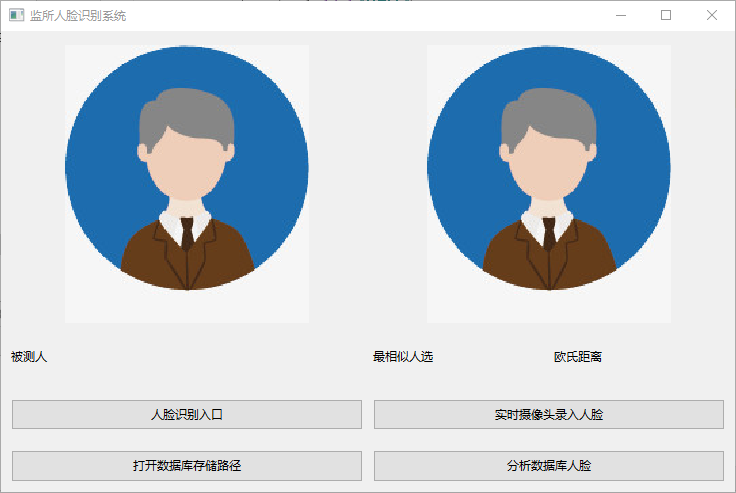利用 Python 开发,借助 Dlib 库捕获摄像头中的人脸,提取人脸特征,通过计算特征值之间的欧氏距离,来和预存的人脸特征进行对比,判断是否匹配,达到人脸识别的目的;
- 完成的功能
- 新的人脸数据集和识别模型
- 做到视频识别, 实时显示人脸信息
- 可摄像头添加人脸, 且可改名
- 可通过文件夹方式批量添加人脸
- GUI化, 基本无卡顿
Detect and recognize single/multi-faces from camera;
调用摄像头进行人脸识别,支持多张人脸同时识别;
摄像头人脸录入 / Face register
请不要离摄像头过近,人脸超出摄像头范围时会有 "OUT OF RANGE" 提醒 / Please do not be too close to the camera, or you can't save faces with "OUT OF RANGE" warning;
- 提取特征建立人脸数据库 / Generate database from images captured
利用摄像头进行人脸识别 / Face recognizer
当单张人脸 / When single-face:
当多张人脸 / When multi-faces:
一张已录入人脸 + 未录入 unknown 人脸 / 1x known face + 2x unknown face:
同时识别多张已录入人脸 / multi-faces recognition at the same time:
** 关于精度 / About accuracy:
- When using a distance threshold of
0.6, the dlib model obtains an accuracy of99.38%on the standard LFW face recognition benchmark.
** 关于算法 / About algorithm
- 基于 Residual Neural Network / 残差网络的 CNN 模型;
- This model is a ResNet network with 29 conv layers. It's essentially a version of the ResNet-34 network from the paper Deep Residual Learning for Image Recognition by He, Zhang, Ren, and Sun with a few layers removed and the number of filters per layer reduced by half.
此项目中人脸识别的实现流程 / The design of this repo:
安装依赖库 / Install some python packages if needed
pip3 install opencv-python pip3 install scikit-image pip3 install dlib pip install wxPython-4.0.0a2.dev3038+953a2e5-cp27-cp27mu-linux_x86_64.whl
下载源码 / Download zip from website or via GitHub Desktop in windows, or git clone repo in Ubuntu
git clone https://github.com/coneypo/Dlib_face_recognition_from_camera
进行人脸信息采集录入 / Register faces
python3 get_face_from_camera.py
提取所有录入人脸数据存入 "features_all.csv" / Features extraction and save into "features_all.csv"
python3 features_extraction_to_csv.py
调用摄像头进行实时人脸识别 / Real-time face recognition
python3 face_reco_from_camera.py
Repo 的 tree / 树状图:
.
├── main_interface.py # Step0. Start First
├── get_faces_from_camera.py # Step1. Faces register
├── features_extraction_to_csv.py # Step2. Features extraction
├── face_reco_from_camera.py # Step3. Faces recognition
├── how_to_use_camera.py # Use the default camera by opencv
├── data
│ ├── data_dlib # Dlib's model
│ │ ├── dlib_face_recognition_resnet_model_v1.dat
│ │ ├── shape_predictor_5_face_landmarks.dat
│ │ └── shape_predictor_68_face_landmarks.dat
│ ├── data_faces_from_camera # Face images captured from camera (will generate after step 1)
│ │ ├── person_1
│ │ │ ├── img_face_1.jpg
│ │ │ └── img_face_2.jpg
│ │ └── person_2
│ │ └── img_face_1.jpg
│ │ └── img_face_2.jpg
│ └── features_all.csv # CSV to save all the features of known faces (will generate after step 2)
├── introduction # Some files for readme.rst
│ ├── main_figure_interface.png
│ ├── main_interface.png
│ └── overview.png
├── README.md
└── requirements.txt # Some python packages needed用到的 Dlib 相关模型函数:
Dlib 正向人脸检测器 (based on HOG), output: <class 'dlib.dlib.rectangles'>
detector = dlib.get_frontal_face_detector() faces = detector(img_gray, 0)
Dlib 人脸预测器, output: <class 'dlib.dlib.full_object_detection'>, will use shape_predictor_68_face_landmarks.dat
# This is trained on the ibug 300-W dataset (https://ibug.doc.ic.ac.uk/resources/facial-point-annotations/) # Also note that this model file is designed for use with dlib's HOG face detector. # That is, it expects the bounding boxes from the face detector to be aligned a certain way, the way dlib's HOG face detector does it. # It won't work as well when used with a face detector that produces differently aligned boxes, # such as the CNN based mmod_human_face_detector.dat face detector. predictor = dlib.shape_predictor("data/data_dlib/shape_predictor_68_face_landmarks.dat") shape = predictor(img_rd, faces[i])
特征描述子 Face recognition model, the object maps human faces into 128D vectors
face_rec = dlib.face_recognition_model_v1("data/data_dlib/dlib_face_recognition_resnet_model_v1.dat")
Python 源码介绍如下:
get_face_from_camera.py:
进行 Face register / 人脸信息采集录入
- 请注意存储人脸图片时,矩形框不要超出摄像头范围,要不然无法保存到本地;
- 超出会有 "out of range" 的提醒;
features_extraction_to_csv.py:
从上一步存下来的图像文件中,提取人脸数据存入CSV;
- 会生成一个存储所有特征人脸数据的 "features_all.csv";
- size: n*128 , n means n people you registered and 128 means 128D features of the face
face_reco_from_camera.py:
这一步将调用摄像头进行实时人脸识别; / This part will implement real-time face recognition;
- Compare the faces captured from camera with the faces you have registered which are saved in "features_all.csv"
- 将捕获到的人脸数据和之前存的人脸数据进行对比计算欧式距离, 由此判断是否是同一个人;


